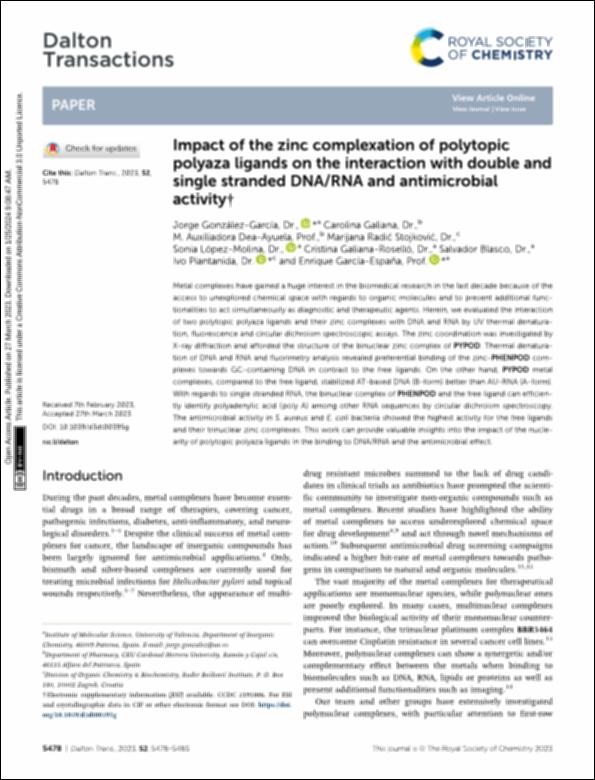Por favor, use este identificador para citar o enlazar este ítem:
http://hdl.handle.net/10637/15109Impact of the zinc complexation of polytopic polyaza ligands on the interaction with double and single stranded DNA/RNA and antimicrobial activity
| Título : | Impact of the zinc complexation of polytopic polyaza ligands on the interaction with double and single stranded DNA/RNA and antimicrobial activity |
| Autor : | González García, Jorge Galiana Roselló, Carolina Dea Ayuela, María Auxiliadora Radic Stojkovic, Marijana López Molina, Sonia Galiana Roselló, Cristina Blasco, Salvador Piantanida, Ivo García-España, Enrique |
| Materias: | Medicamento; Drugs; Análisis espectroquímico; Spectrochemical analysis; Metal; Metals; Elemento químico; Chemical elements |
| Editorial : | Royal Society of Chemistry |
| Citación : | González García, J., Galiana, C., Dea Ayuela, M.A., Radic Stojkovic, M., López Molina, S., Galiana Roselló, C., Blasco, S., Piantanida, I. & García-España, E. (2023). Impact of the zinc complexation of polytopic polyaza ligands on the interaction with double and single stranded DNA/RNA and antimicrobial activity. Dalton Transactions, vol. 52, i. 17, pp. 5478-5485. DOI: https://doi.org/10.1039/D3DT00395G |
| Resumen : | Metal complexes have gained a huge interest in the biomedical research in the last decade because of the access to unexplored chemical space with regards to organic molecules and to present additional functionalities to act simultaneously as diagnostic and therapeutic agents. Herein, we evaluated the interaction of two polytopic polyaza ligands and their zinc complexes with DNA and RNA by UV thermal denaturation, fluorescence and circular dichroism spectroscopic assays. The zinc coordination was investigated by X-ray diffraction and afforded the structure of the binuclear zinc complex of PYPOD. Thermal denaturation of DNA and RNA and fluorimetry analysis revealed preferential binding of the zinc-PHENPOD complexes towards GC-containing DNA in contrast to the free ligands. On the other hand, PYPOD metal complexes, compared to the free ligand, stabilized AT-based DNA (B-form) better than AU-RNA (A-form). With regards to single stranded RNA, the binuclear complex of PHENPOD and the free ligand can efficiently identify polyadenylic acid (poly A) among other RNA sequences by circular dichroism spectroscopy. The antimicrobial activity in S. aureus and E. coli bacteria showed the highest activity for the free ligands and their trinuclear zinc complexes. This work can provide valuable insights into the impact of the nuclearity of polytopic polyaza ligands in the binding to DNA/RNA and the antimicrobial effect. |
| URI : | http://hdl.handle.net/10637/15109 |
| Derechos: | Open Access https://creativecommons.org/licenses/by-nc/4.0/deed.es |
| ISSN : | 1477-9226 1477-9234 (Electrónico) |
| Fecha de publicación : | 27-mar-2023 |
| Centro : | Universidad Cardenal Herrera-CEU |
| Aparece en las colecciones: | Dpto. Farmacia |
Los ítems de DSpace están protegidos por copyright, con todos los derechos reservados, a menos que se indique lo contrario.


